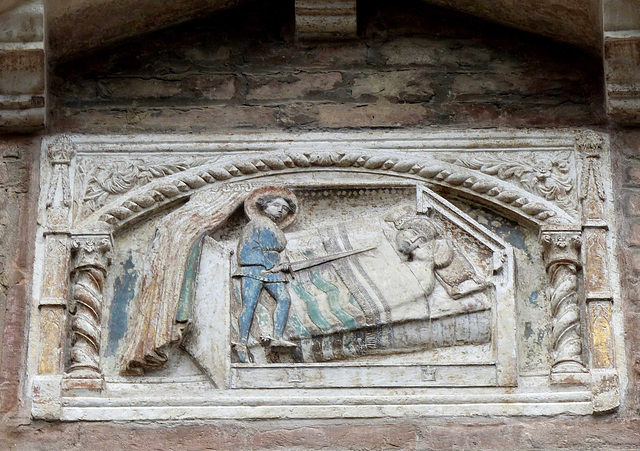Ferrara - Tabaccheria Garibaldi
Ferrara - Cattedrale di San Giorgio (PiP)
Ferrara - Cattedrale di San Giorgio
Ferrara - Cattedrale di San Giorgio
Ferrara - Girolamo Savonarola
Ferrara - Mercato coperto di Santo Stefano
Ferrara - Museo della Cattedrale
Ferrara - Museo della Cattedrale
Ferrara - Museo della Cattedrale
Ferrara - Museo della Cattedrale
Ferrara - Museo della Cattedrale
Ferrara - Museo della Cattedrale
Ferrara - Museo della Cattedrale
Ferrara - Museo della Cattedrale
Ferrara - Museo della Cattedrale
Ferrara - Museo della Cattedrale
Ravenna - Torre Civica
Ravenna - Kiosk
Ravenna - Battistero Neoniano
Ravenna - Battistero Neoniano
Ravenna - Battistero Neoniano
Ravenna - Battistero Neoniano
Ravenna - Chiesa di Santa Giustina
Ferrara - Chiesa di San Giuliano
Ferrara - Poste e Telegrafi
Ferrara - Castello Estense
Ferrara - Castello Estense
Bentivoglio - Municipio
Bologna - Cattedrale Metropolitana di San Pietro
Bologna - Cattedrale Metropolitana di San Pietro
Bologna - Cattedrale Metropolitana di San Pietro
Bologna - Oratorio dello Spirito Santo
Bologna - Basilica di San Martino
Bologna - Basilica di San Francesco
Bologna - Basilica dei SS. Vitale e Agricola
Bologna - Basilica del Sepolcro
Bologna - Basilica dei SS. Vitale e Agricola
Bologna
Bologna - Piazza del Nettuno
Bologna - Piazza Maggiore
Bologna - Basilica di San Petronio
Bologna - Basilica di San Petronio
Bologna - Basilica di San Petronio
Bologna
Bologna - Central Fiori
Location
Keywords
Authorizations, license
-
Visible by: Everyone -
All rights reserved
-
23 visits
Ferrara - Chiesa di San Giuliano


Ferrara appears first in a document of the Lombard king Desiderius of 753 when he captured the town from the Exarchate of Ravenna. Later the Franks, after routing the Lombards, presented Ferrara to the Papacy in 754. In 988 Ferrara was ceded by the Church to the House of Canossa, but at the death of Matilda of Tuscany in 1115, it became a free commune. During the 12th century, the history of the town was marked by the wrestling for power between the Guelph Adelardi and the Ghibelline Salinguerra families. The Ghibellines won and in 1264 Obizzo II d'Este was proclaimed lifelong ruler of Ferrara. His rule marked the end of the communal period in Ferrara and the beginning of the Este rule, which lasted until 1598.
Near the present church of San Giuliano was already a church in the 13th century, demolished in 1385 to make way for the construction of the Castello Estense. The new church was built in 1405 by a citizen on land donated by Marquis Niccolò II.
From the time of the Este family, this building housed the arts of innkeepers, goldsmiths and fishmongers until 1616, under the patronage of the Avogari, one of the city's most famous families.
In 1796 the church was closed and remained closed for years. To prevent its desecration and possible demolition, the priest Count Don Pietro Dalla Fabbra bought the church. It changed hands a couple of times. It was restored in the 19th century and again in the mid-20th century. By now it is in the possession of the archdiocese.
On the outside wall is this carving from the 15th century, depicting San Guiliano killing his parents.
The legend of Giuliano (Julianus) originated in the 9th century. Jacobus de Voragine added it to the famous "Legenda Aurea".
According to the tradition reproduced in the "Legenda Aurea", Giuliano unknowingly killed his parents. To atone, he made a pilgrimage to Rome. Afterward, he is said to have settled by a river and helped travelers cross.
Near the present church of San Giuliano was already a church in the 13th century, demolished in 1385 to make way for the construction of the Castello Estense. The new church was built in 1405 by a citizen on land donated by Marquis Niccolò II.
From the time of the Este family, this building housed the arts of innkeepers, goldsmiths and fishmongers until 1616, under the patronage of the Avogari, one of the city's most famous families.
In 1796 the church was closed and remained closed for years. To prevent its desecration and possible demolition, the priest Count Don Pietro Dalla Fabbra bought the church. It changed hands a couple of times. It was restored in the 19th century and again in the mid-20th century. By now it is in the possession of the archdiocese.
On the outside wall is this carving from the 15th century, depicting San Guiliano killing his parents.
The legend of Giuliano (Julianus) originated in the 9th century. Jacobus de Voragine added it to the famous "Legenda Aurea".
According to the tradition reproduced in the "Legenda Aurea", Giuliano unknowingly killed his parents. To atone, he made a pilgrimage to Rome. Afterward, he is said to have settled by a river and helped travelers cross.
aNNa schramm has particularly liked this photo
- Keyboard shortcuts:
Jump to top
RSS feed- Latest comments - Subscribe to the comment feeds of this photo
- ipernity © 2007-2024
- Help & Contact
|
Club news
|
About ipernity
|
History |
ipernity Club & Prices |
Guide of good conduct
Donate | Group guidelines | Privacy policy | Terms of use | Statutes | In memoria -
Facebook
Twitter

Sign-in to write a comment.